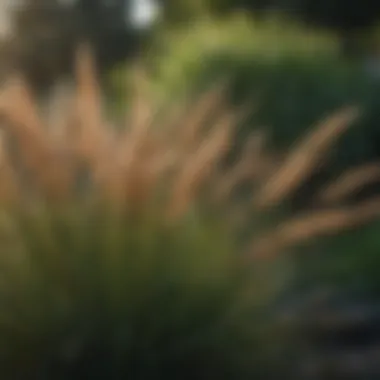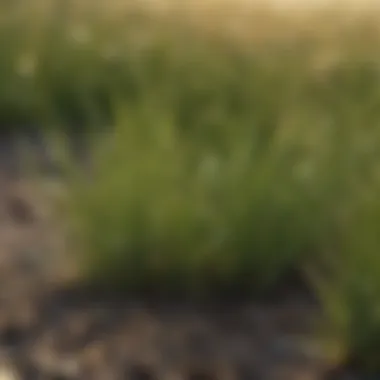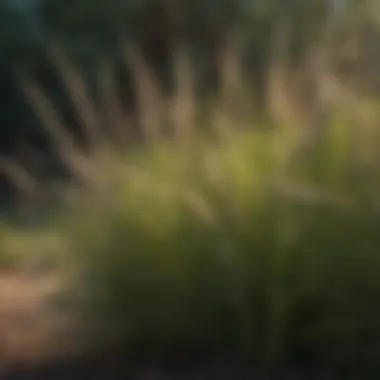An In-Depth Exploration of Hardy Lawn Grasses


Intro
Hardy lawn grasses are not only a key component of beautiful landscapes but also play a crucial role in sustainable gardening and horticulture. They offer the resilience needed to thrive across diverse climates, improving the health and aesthetics of outdoor spaces. Understanding the various types of hardy grasses, their maintenance requirements, and ecological benefits allows landowners and garden enthusiasts to make informed choices. In this article, we will explore the adaptability of these grasses and how to effectively incorporate them into different landscapes.
Research and Data Analysis
Latest Trends in Agriculture and Horticulture
As the world shifts towards sustainable practices, hardy lawn grasses are increasingly recognized for their environmental advantages. Research highlights that these grass types require less water and fewer chemical inputs, making them ideal for eco-conscious gardeners. The rise of xeriscaping practices has also prompted interest in drought-tolerant species like Festuca glauca, which can thrive in arid conditions yet maintain a lush appearance.
Statistical Insights into Crop Yields
The economic significance of hardy grasses extends beyond aesthetic appeal. Studies show that implementing hardy grass species can enhance soil quality and reduce erosion, leading to higher overall crop yields in agricultural settings. For instance, a survey indicated that farms using drought-resistant grasses reported a yield increase of up to 15% under low-water conditions. These insights underscore the value of hardy grasses as a strategic choice for both residential landscapes and commercial agriculture.
Best Practices and Techniques
Efficient Crop Management Strategies
To effectively manage lawns composed of hardy grasses, several best practices should be considered. Regular mowing at the appropriate height encourages healthy growth and reduces weed issues. Applying a slow-release fertilizer in spring caters to the nutrient needs without over-fertilizing, promoting balance in soil health.
Sustainable Horticultural Techniques
Selecting native or adapted grass species is fundamental to sustainability. These grasses often require less maintenance and are more resilient against local pest pressures and diseases. Using organic amendments such as compost improves soil structure and fosters beneficial microbial activity, contributing to a healthier lawn ecosystem.
"Sustainable practices, including the use of native grasses, can lead to significant ecological benefits while reducing maintenance efforts."
Pest and Disease Management
Common Pests and Diseases in Crops
Understanding pest and disease dynamics is vital in maintaining hardy lawn grasses. Common issues include grubs, armyworms, and diseases such as dollar spot. Regular monitoring and prompt action can prevent infestations from escalating and affecting grass health.
Integrated Pest Management Strategies
Adopting an Integrated Pest Management (IPM) approach is effective for controlling pests without harming the environment. This includes cultural practices like crop rotation and the use of resistant grass varieties. Biological control methods, such as introducing predatory insects, also play a crucial role in managing pest populations naturally.
Understanding Hardy Lawn Grasses
Hardy lawn grasses present unique attributes that are essential for achieving vibrant landscapes. Understanding these grasses begins with recognizing their adaptability and resilience. These varieties can endure various environmental conditions, making them suitable for diverse geographical areas. They provide benefits beyond aesthetics; they contribute to sustainable landscaping practices.
Definition and Characteristics
Hardy lawn grasses are defined by their ability to thrive in challenging conditions. This includes tolerance to drought, temperature extremes, and foot traffic. Common characteristics of these grasses include deep root systems, which enable them to access moisture and nutrients more efficiently. Their growth habits vary, influencing how they fill in areas and compete with weeds. In essence, hardy grasses can be categorized into cool-season and warm-season types, based on their growing periods. Understanding these facets can aid in selecting the appropriate grass species for specific settings.
Importance in Landscaping
The significance of hardy lawn grasses in landscaping extends beyond mere appearance. They play a crucial role in soil conservation and reduction of erosion. Thicker grassy layers can prevent surface runoff during heavy rains, which is beneficial for maintaining soil health. Additionally, they require less water and fertilizer compared to other varieties, making them an eco-friendly choice.
Adopting hardy grasses is also a strategy for creating sustainable gardens, as they may support local biodiversity. Local wildlife, including pollinators, can find refuge in these ecosystems. By incorporating these grasses, you are not just planting a lawn; you are fostering a microhabitat that promotes life.
"Choosing hardy lawn grasses is not merely an aesthetic decision; it is a commitment to environmental stewardship."
In summary, a strong grasp of hardy lawn grasses is fundamental for anyone involved in landscaping or gardening. With their durable nature and ecological advantages, understanding these grasses can greatly enhance both the beauty and functionality of outdoor spaces.


Types of Hardy Lawn Grasses
Understanding the various types of hardy lawn grasses is crucial for anyone looking to create a resilient and attractive landscape. These grasses offer a multitude of benefits, including adaptability to different environments, low maintenance requirements, and ecological advantages. A well-chosen hardy grass can withstand local climate challenges, making it an essential component of sustainable landscaping.
Perennial Ryegrass
Perennial Ryegrass is known for its rapid germination and establishment. This grass type is often used for quick patches in lawns and overseeding. One of its main advantages is its ability to thrive in cooler temperatures. Its fine texture and rich green color make it visually appealing. Additionally, it can tolerate moderate foot traffic, making it suitable for residential lawns and parks.
Tall Fescue
Tall Fescue offers excellent drought resistance, making it a choice for areas with limited water. This grass typically has a coarser texture compared to other types. Its deep root system allows it to access moisture deep in the soil, which helps it survive during dry spells. Moreover, Tall Fescue is adaptable to various soil types, which adds to its appeal for diverse landscaping projects. It remains green longer into the fall than many other grasses, providing extended aesthetic benefits.
Kentucky Bluegrass
Kentucky Bluegrass is admired for its lush, dense growth and vibrant color. It spreads through underground rhizomes, which helps it fill in bare patches naturally. The grass thrives in a variety of soils and can withstand cold winters, making it popular in northern climates. However, it requires more maintenance than some other hardy grasses, including regular watering and fertilization to maintain its color and density. Its beauty and resilience make it a staple for homeowners and landscaping professionals alike.
Bermudagrass
Bermudagrass is a warm-season grass that thrives in sunny environments. It establishes quickly and is well-suited for areas with heavy foot traffic, such as sports fields and golf courses. Its durability and ability to recover from damage make it a top choice for functional landscapes. However, it can go dormant in cooler temperatures, which may limit its use in northern regions. Therefore, it is best to use Bermudagrass in southern climates or areas with hot summers.
Fine Fescue
Fine Fescue is a group of grasses that includes Creeping Red Fescue, Chewings Fescue, and Hard Fescue. Known for their fine blades, these grasses are ideal for shady areas where other grasses may struggle. They require less water and can thrive in poor soil conditions. Their low growth habit also reduces the need for frequent mowing. Fine Fescue grasses are often used in blends to create a lush and dense lawn, particularly in cool-season regions.
Selecting the Right Grass for Your Needs
Choosing the appropriate grass for your lawn is more than just aesthetics. The right type of grass ensures durability and long-term sustainability in your landscape. Each species has unique needs and adapts differently to local conditions. Understanding these aspects can save time and resources, ultimately leading to a healthier lawn.
Considerations for Climate
The climate in which you live is a primary factor influencing your selection of grass type. Different grasses perform optimally under varying temperature and moisture conditions. For instance, Perennial Ryegrass thrives in cooler climates and is known for its quick germination, while Bermudagrass prefers warm temperatures and is often chosen for sunny regions.
Before buying seeds or sod, assess your local climate. Are winters harsh and long? Do summers bring extreme heat? Plan accordingly, as these conditions will dictate which grasses will flourish in your yard. For example, choosing a grass like Tall Fescue could be beneficial if you experience a mix of hot summers and cold winters, due to its adaptability.
Soil Type and Preparation
Understanding your soil type is crucial. The texture, pH, and drainage of your soil can affect grass growth and health. Clay, sandy, or loamy soils each harbor different properties. Grasses like Kentucky Bluegrass function best in loamy soils, which retain moisture while allowing drainage. Conversely, Fine Fescue is lighter and suitable for sandy soils, often requiring less water.
Before sowing, conducting a soil test is advisable. This will help identify any nutrient deficiencies or pH imbalances, enabling informed decisions about amendments like lime or sulfur. Proper soil preparation can involve tilling, aerating, and adding organic matter to enhance soil structure and fertility. The ultimate goal is to create a foundation that supports robust grass growth.
Usage: Ornamental vs. Functional
Deciding between ornamental and functional uses of your lawn grass can influence your choice significantly. Ornamental grasses, such as Bermudagrass, can provide a lush, manicured appearance for polished landscapes. They are often chosen for their visual appeal and ability to enhance the aesthetic of home gardens and parks.
On the other hand, functional grasses like Tall Fescue not only look good but also withstand heavy foot traffic. These varieties are perfect for sports fields or families who enjoy outdoor activities. Understanding the primary function of your lawn (whether for aesthetic beauty or heavy use) will guide you in selecting a grass type that best meets those needs.
Sowing and Establishing Hardy Grasses
Sowing and establishing hardy grasses is a crucial step in creating a vibrant and healthy lawn. It sets the foundation for a robust landscape that can withstand various environmental stresses. This section will explore the methods and considerations involving the sowing process to ensure the successful establishment of hardy grasses. By understanding the elements and benefits, enthusiasts can achieve a thriving lawn that is both functional and aesthetically pleasing.
Seed Selection Strategies
Choosing the right seeds is fundamental in establishing hardy grasses successfully. The specific requirements of the environment must be taken into account. For example, factors such as climate, soil type, and intended use of the lawn play a significant role in this selection.


- Assess Climate Conditions: Different grass types, like Kentucky Bluegrass or Tall Fescue, have unique climate preferences. Selecting a species suited for your region’s climate can enhance growth and resilience.
- Soil Analysis: Conduct a soil test to determine pH levels and nutrient content. Grasses respond differently to soil conditions. Knowing the composition helps to make informed choices.
- Evaluating Microclimates: Within your yard, some areas may have unique microclimates. For instance, shaded areas might require shades-tolerant grass types while sunny spots can support drought-tolerant species.
These strategies ensure that the selected seeds align with the local environment’s expectations.
Best Practices for Sowing
Once the appropriate seeds are chosen, the next step focuses on the actual sowing process. Implementing best practices can significantly impact the establishment phase.
- Timing: The timing of sowing is essential. Spring or early fall are generally the best times to sow seeds, allowing the grass to establish before extreme weather conditions.
- Soil Preparation: Properly prepare the soil by tilling it to a depth of at least four inches. Remove rocks, weeds, and debris as this will create an optimal environment for grass growth.
- Seeding Evenly: Use a broadcast spreader to ensure even distribution of seeds. Uneven seeding can lead to patches and poor growth in some areas.
- Lightly Rake: After seeding, lightly rake the soil to cover the seeds with a thin layer of soil. This helps retain moisture while protecting the seeds from birds and wind.
Following these best practices contributes to a more uniform and resilient lawn, making the establishment process smoother and more effective.
Optimal Growth Conditions
Creating ideal growth conditions is vital for the successful establishment of hardy grasses. Attention to these conditions ensures the seeds thrive once sown.
- Moisture Management: The first few weeks after sowing is critical. Consistent moisture is necessary for germination. Light, frequent watering is preferable to deep but infrequent watering.
- Temperature Monitoring: Grass seeds have temperature preferences for germination. Seeds often germinate best at temperatures between 65°F to 75°F. Monitoring soil temperature can achieve a successful planting.
- Fertilization: A starter fertilizer rich in phosphorus can assist in root development. Apply this fertilizer at planting to enhance nutrient availability during the initial growth phase.
- Weed Control: Weeds can compete for resources, hindering grass establishment. Implementing a pre-emergent herbicide might be beneficial, ensuring it does not affect the grass being sown.
Maintenance of Hardy Lawn Grasses
Proper maintenance of hardy lawn grasses is essential for ensuring their longevity and health. Understanding the unique characteristics of these grass types allows one to tailor a maintenance regime that meets their specific needs. A well-maintained lawn not only enhances aesthetic appeal but also improves functionality, making the space more usable and increasing its ecological benefits. In the context of sustainability, effective maintenance practices also reduce resource consumption over time.
Watering Guidelines
Watering is a fundamental aspect of lawn care. Hardy grasses have different water requirements based on their species, climate, and soil type.
- Frequency: Generally, watering should occur when the top inch of soil feels dry. Deep, infrequent watering encourages deep root growth, which enhances drought resilience.
- Timing: Early morning is the best time to water. This helps minimize evaporation and fungal diseases. Watering in the evening can lead to prolonged moisture on the grass, which attracts pests.
- Amount: Aim for about one to one and a half inches of water per week. This can be adjusted based on rainfall and seasonal changes.
These guidelines foster healthier grass that can better withstand environmental stressors.
Mowing Techniques
Mowing is not just for aesthetics; it is critical for grass health. Proper mowing techniques promote denser grass and improve overall resilience.
- Height: Different grass types have ideal cutting heights. For instance, Kentucky Bluegrass thrives when cut to 2.5 to 4 inches. Cutting too short can stress the plant and expose the soil.
- Frequency: Mow regularly to keep the grass at its desired height. This also helps to deter weeds from taking root.
- Sharp Blades: Use sharp mower blades. Dull blades tear grass rather than cutting it cleanly, which can lead to disease.
Following these mowing practices ensures healthy growth while maintaining the visual integrity of your lawn.
Fertilization Requirements
Fertilization provides the necessary nutrients for hardy grasses to thrive. The type and amount of fertilizer depend on various factors, including grass species, soil quality, and growth stage.
- Soil Testing: Conduct soil tests to determine nutrient needs. This ensures that the right fertilizers are used, reducing excess application which can harm the environment.
- Type of Fertilizer: Choose between organic options, such as compost or manure, and synthetic ones based on the lawn’s specific needs. Organic fertilizers improve soil structure whereas synthetic types provide immediate nutrients.
- Timing: Generally, fertilization should occur in early spring and again in the fall. These times align with the natural growth cycles of most hardy grasses.
Effective fertilization nurtures grass and supports its ability to resist pests and diseases.
Weed and Pest Control
Weed and pest management is vital for maintaining a healthy lawn. Weeds compete with grass for resources, while pests can damage or kill the grass.
- Pre-emergent Herbicides: Applying these before weeds sprout can prevent them from establishing. However, timing is essential, as application too early or too late can be ineffective.
- Cultural Practices: Practices such as proper mowing and aeration help reduce weed emergence and pest populations. Encourage beneficial insects like ladybugs and lacewings that prey on harmful pests.
- Monitor Regularly: Regular inspections will help quickly identify any issues. This enables targeted action before they spread.
By implementing effective weed and pest control strategies, you protect the investment you have made in your lawn and promote overall ecological health.


Ecological Benefits of Hardy Grasses
Hardy lawn grasses are not only valued for their aesthetic appeals but also for their significant ecological benefits. They play a pivotal role in promoting environmental health through various mechanisms that enhance soil quality, foster biodiversity, and improve resilience against climate change. Understanding these benefits is crucial for anyone serious about sustainable landscaping, as it highlights the importance of selecting the right grasses for both functional and ecological purposes.
Soil Erosion Control
One of the primary ecological benefits of hardy grasses is their capacity for soil erosion control. Grasses, with their deep root systems, help bind the soil together, preventing it from washing away during heavy rainfall. This is especially vital in areas that experience frequent rainfalls or near waterways.
- Root Structure: The robust root systems of hardy grasses provide stability to the soil. Their roots penetrate deep into the earth, anchoring the soil and reducing erosion risk.
- Ground Cover: Hardy grasses create a dense ground cover that absorbs rainfall, allowing water to infiltrate rather than run off. This helps to maintain soil moisture and prevents the surface soil from being displaced.
By incorporating hardy grasses into landscaping and agriculture, both homeowners and farmers can mitigate soil erosion, thereby sustaining soil health and fertility over time.
Biodiversity Promotion
In addition to stabilizing soil, hardy grasses play a vital role in promoting biodiversity. A diverse ecosystem is essential for a healthy environment, and grasses can support a range of creatures.
- Habitat Formation: Hardy grasses provide a habitat for various microorganisms, insects, and small animals. This supports the food chain, contributing to a more complex and resilient ecosystem.
- Nutrient Cycling: Different species of grasses contribute to nutrient cycling, which is essential for maintaining overall soil health. They can provide habitat for pollinators and other beneficial insects that further enhance ecological balance.
- Interconnectedness: Integrating hardy grasses into your landscape can lead to increased plant and animal diversity. This interconnectedness boosts ecological stability, which is essential for long-term sustainability.
Climate Resilience
Hardy lawn grasses also contribute towards climate resilience. As climatic conditions become more unpredictable, the adaptability of these grasses can play a significant role in mitigating climate-related effects.
- Drought Tolerance: Many hardy grass species possess exceptional drought tolerance. This characteristic allows them to thrive in conditions where other plants may struggle, thus maintaining green spaces even during dry spells.
- Carbon Sequestration: Hardy grasses have the ability to sequester carbon. They absorb carbon dioxide from the atmosphere, helping to combat climate change by reducing greenhouse gas concentrations.
- Microclimate Regulation: Areas planted with hardy grasses can help moderate temperature fluctuations. This leads to cooler ground temperatures in summer and warmer temperatures in winter, making them valuable for microclimate regulation.
In summary, the ecological benefits of hardy lawn grasses extend beyond mere beautification. Their contributions to soil erosion control, biodiversity promotion, and climate resilience make them essential in sustainable landscape practices. Incorporating these grasses is not just an investment in one’s property but a commitment to fostering a healthier environment.
Future Trends in Hardy Grass Research
The exploration of hardy grasses encompasses not only their current applications but also future advancements that can enhance their performance and sustainability. Understanding the emerging trends in research is vital for ensuring the adaptability of these grasses to changing climates and landscaping needs. This section outlines significant developments that promise to shape the future of hardy grass varieties, while addressing practical implications for users.
Genetic Developments
Advancements in genetic research are paving the way for the creation of improved grass species. Scientists are actively working on genetically modified strains that exhibit higher drought resistance, which is critical in regions facing water scarcity. These developments aim to provide stronger root systems and better nutrient uptake, ensuring more resilient lawns.
The use of molecular markers is a key component in this research, enabling faster identification of desirable traits within grass populations. This method can significantly reduce the time needed for traditional breeding programs. Through these genetic advancements, it is possible to combine qualities from various grass types, resulting in hybrids that perform exceptionally well in diverse conditions.
The role of biotechnology in grass development is not just about efficiency; it also raises questions about ecological impacts and public acceptance.
Additionally, epigenetic modifications offer another layer of potential. By altering gene expression without changing the underlying DNA sequence, researchers can enhance stress responses and growth rates more sustainably. This area of research is promising, as it opens up possibilities to enhance existing species without introducing foreign genes into the ecosystem.
Sustainable Practices
The pursuit of sustainability is at the forefront of current trends in hardy grass research. Effective practices are being devised that not only maintain grass quality but also contribute positively to the environment. A critical aspect here involves the integration of native grass species, which tend to require less water and fertilizer compared to non-native varieties.
Encouraging biodiversity within lawns can lead to healthier ecosystems. By mixing various grass types, it is possible to increase resistance against pests and diseases, which in turn minimizes the reliance on chemical herbicides and pesticides.
In terms of maintenance, research is also focused on more sustainable fertilization techniques. Slow-release fertilizers and organic composts are gaining popularity. These methods reduce the risk of nutrient runoff, which is a significant contributor to waterway pollution. Moreover, they can improve the overall health of the soil, allowing grass to thrive while maintaining ecological balance.
Some landscapers are experimenting with low-mow or no-mow strategies. These methods support deeper root systems and require fewer resources over time. Usually, they also enhance the aesthetic appeal of lawns by promoting the growth of wildflowers and other beneficial plants that coexist with hardy grasses.
As the agriculture and landscaping industries evolve, the emphasis on sustainable practices becomes essential. This focus not only addresses environmental concern but also caters to consumer preferences for eco-friendly solutions.
Epilogue
In this article, we explored the multifaceted world of hardy lawn grasses. These grasses offer not only aesthetic appeal but also practical benefits for sustainable landscaping. The significance of hardy grasses can be summarized through several key points.
Firstly, hardy lawn grasses are well-adapted to various climates. They can withstand environmental stresses, which reduces the need for extensive inputs such as water and fertilizers. This adaptability makes them an ideal choice for environmentally conscious landscaping projects.
Furthermore, the maintenance requirements for these grasses are generally lower compared to more delicate varieties. Reduced mowing, less frequent watering, and limited pest control measures contribute to an easier upkeep schedule. This efficiency saves both time and resources for homeowners and landscape managers alike.
Another important aspect is the ecological benefits provided by hardy grasses. They play a pivotal role in soil erosion control, helping to maintain soil integrity. Additionally, these grasses promote biodiversity by supporting various beneficial insects and organisms. A diverse ecosystem adds resilience to landscapes, making them more capable of withstanding climate impacts.















